Pork Labelling Guide
Use this pork labelling guide to find out what the labels really mean for pigs. Only buy high welfare labels, such as *RSPCA Assured, Free Range or best of all Organic. These pigs will have been raised on high welfare farms, almost certainly in the UK. You can find pork with high welfare labels in most supermarkets. #JustAsk for high welfare at your local butcher, or better still shop at your local farmers’ market, find high welfare online, or join a box scheme. If you’re eating out, #JustAsk if the meat is from a high welfare farm.
Common Labels
A Closer Look
Organic
Both breeding sows and fattening pigs can roam freely between outdoors and shelter their entire lives. They have access to straw bedded huts for shelter, but are always free to roam and forage for a natural diet. Piglets are weaned no earlier than 40 days, meaning they have much more time with their mothers than in intensive systems. The use of any GM pig feed is banned, this means that the pig feed is likely to be locally supplied and sustainable grown. NB. The ‘Soil Association Organic Standard’ is one of only a few schemes that chooses to “set it’s standards even higher than the minimum EU organic requirements”.
Example labels:





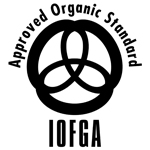
Free Range
Both breeding sows and fattening pigs can roam freely between outdoors and shelter their entire lives. They have access to straw bedded huts for shelter, but are always free to roam and forage for a natural diet. Piglets are usually weaned at 7-8 weeks. There is no official logo for free range, so look for the words ‘free range’ on the packaging.
Example packaging:

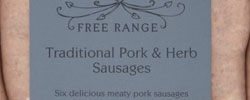
RSPCA Assured & Outdoor Reared
Breeding sows are free range meaning that they can roam freely between outdoors and shelter for their whole lives and are never confined in metal cages. Sows have access to large bedded huts that provide shelter and a dry lying area. Sows give birth to their litters outdoors in individual straw-bedded shelters called arcs from which they come and go freely. The fattening pigs are moved indoors into light and airy straw-based systems, rather than intensive systems after weaning (up to ten weeks). Look for the RSPCA Assured logo and the words ‘outdoor reared‘ on the packaging.
Example packaging:
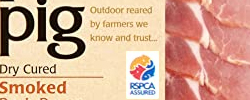
RSPCA Assured & Outdoor Bred
Breeding sows are free range meaning that they can roam freely between outdoors and shelter for their whole lives and are never confined in metal cages. Sows have access to large bedded huts that provide shelter and a dry lying area. Sows give birth to their litters outdoors in individual straw-bedded shelters called arcs from which they come and go freely. The fattening pigs are moved indoors into light and airy straw-based systems, rather than intensive systems after weaning (around four weeks). Look for the RSPCA Assured logo and the words ‘outdoor bred‘ on the packaging.
Example packaging:


RSPCA Assured
The scheme covers both indoor and outdoor rearing systems. Pigs that are permanently indoors have more space to move and are provided with material such as straw to root around in. Breeding sows are never confined in metal cages and are given enough room and straw to build nests. Teeth clipping, nose ringing and tail docking are not permitted except in exceptional circumstances. Look for the RSPCA Assured logo on the packaging.
Logo & example packaging:



Outdoor Reared
Breeding sows are free range meaning that they can roam freely between outdoors and shelter for their whole lives and are never confined in metal cages. Sows have access to large bedded huts that provide shelter and a dry lying area. Sows give birth to their litters outdoors in individual straw-bedded shelters called arcs from which they come and go freely. The piglets are free-range with their mothers until weaning (up to ten weeks), when they are moved indoors. Piglets can be moved into an intensive system post-weaning unless the RSPCA Assured logo is present as well. There is no official logo for outdoor reared, so look for the words ‘outdoor reared‘ on the packaging.
Example packaging:


Outdoor Bred
Breeding sows are free range meaning that they can roam freely between outdoors and shelter for their whole lives and are never confined in crates. Sows have access to large bedded huts that provide shelter and a dry lying area. Sows give birth to their litters outdoors in individual straw-bedded shelters called arcs from which they come and go freely. The piglets are free-range with their mothers until weaning (around four weeks), when they are moved indoors. Piglets are likely moved into an intensive system post-weaning unless the RSPCA logo is present as well. There is no official logo for outdoor bred, so look for the words ‘outdoor bred‘ on the packaging.
Example packaging:
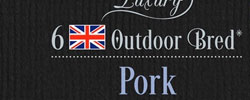

Red Tractor Assured Food Standards
There is very little difference between the minimum Red Tractor standards and the legal minimum UK requirements. The Red Tractor label allows for intensive production and is not a ‘guarantee’ of good animal welfare. Breeding sows can be confined in metal cages, ‘farrowing crates’, for up to five weeks during each pregnancy cycle and piglets can be kept permanently indoors, often on bare concrete or slatted floors. Pigs often suffer from inadequate environmental enrichment, antibiotics overuse, routinely docked tails and routinely clipped teeth. NB. More than 80% of all UK pig farms use the Red Tractor label. If the Red Tractor logo is used in conjunction with any of the higher welfare labels above, then the minimum welfare requirements will be raised to those of the higher welfare label.
Logo & example packaging:

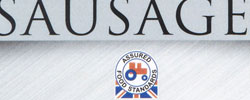

UK Standard (UK pork with no welfare label)
There is very little difference between the minimum UK requirements and the minimum EU requirements, except that ‘sow stalls’ are banned in the UK. Breeding sows are likely to be confined to metal cages, ‘farrowing crates’ for up to 5 weeks during each pregnancy cycle and piglets are kept permanently indoors, often on bare concrete or slatted floors. Pigs often suffer from inadequate environmental enrichment & antibiotics overuse. Routine tail docking and teeth clipping is commonplace. Castration is legal, but not commonplace. There is no official label for UK Standard pork, but the British flag, or the words ‘British Pork’ is often used on packaging.
Example packaging:

EU Standard (EU pork with no welfare label)
Imported pork with no welfare label will almost certainly have come from an intensive factory farm. Breeding sows are very likely to be kept in ‘sow stalls‘ for up to the first four weeks of each pregnancy, then kept in ‘farrowing crates‘ until the piglets are weaned (a further five weeks). Fattening pigs are commonly kept permanently indoors on slatted floors with no bedding. Routine tail docking and routine teeth clipping/grinding has been illegal in the EU since 2003, but remains commonplace. Castration is also commonplace.
Example packaging:


Welfare Indicators
(tap/hover over icons for more information)
What do the different pork labels actually mean for the welfare of the pigs? We’ve selected some key elements of pig welfare and compared them across the different labels.
| Welfare Indicator | Organic | Free Range | RSPCA + Outdoor Reared/Bred | RSPCA Assured | Outdoor Reared | Outdoor Bred | Red Tractor | UK Standard | EU Standard |
|---|---|---|---|---|---|---|---|---|---|
| Pigs Outdoors | |||||||||
| No Cages | |||||||||
| Adequate Straw/Bedding | |||||||||
| No Tail Docking | |||||||||
| No Antibiotics Overuse |
How do Supermarkets Compare?
We surveyed the UK’s top supermarkets and discovered the majority are still selling pork from factory farms in their own-brand fresh pork ranges. If you want to shop more ethically when it comes to buying pork in the supermarket, here’s everything you need to know.

- Majority high welfare
- All M&S own-brand fresh pork is a minimum of RSPCA Assured & Outdoor Bred standard.
- Within their ‘Speciality’ range they stock some free range and organic pork too.

- Majority high welfare
- All of Waitrose’s own-brand fresh pork is comes from UK RSPCA Assured & Outdoor Bred farms as a minimum standard.
- They stock some free range and organic pork too.

- Majority high welfare
- All of Co-op’s own-brand fresh pork is sourced from RSPCA Assured & Outdoor Bred farms.

- Majority low welfare, some high welfare
- Sainsbury’s own-brand fresh pork products are mostly UK Standard or EU Standard.
- The ‘Taste the Difference’ range is RSPCA Assured & Outdoor Bred.

- Majority low welfare, some high welfare
- Aldi stocks a lot of EU Standard, UK Standard & Red Tractor own-brand fresh pork.
- Some of Aldi’s ‘Specially Selected’ range of fresh pork is RSPCA Assured & Outdoor Bred. Make sure that the product has the RSPCA Assured logo & the words ‘outdoor bred’ on the packaging.

- Majority low welfare, some high welfare
- Two thirds of Lidl’s own-brand fresh pork is Red Tractor, which has a low minimum welfare standard.
- Lidl’s fresh pork in their ‘Deluxe’ range is RSPCA Assured & Outdoor Bred, which has a higher minimum welfare standard.

- Majority low welfare, some high welfare
- Morrisons own-brand fresh pork products are Red Tractor or EU Standard, both of which have a low minimum welfare standard.
- Morrisons ‘The Best’ range is no improvement as this is also almost entirely Red Tractor. A very small number of ‘The Best’ cured ham products are RSPCA Assured & Outdoor Bred, which have a high minimum welfare standard. So, unless you are buying cured ham, it is very difficult to buy high welfare pork in Morrisons.

- Majority low welfare, some high welfare
- Tesco stocks Red Tractor, UK Standard and EU Standard own-brand fresh pork products, which all have a low minimum welfare standard.
- Tesco’s ‘Finest’ fresh pork range is RSPCA Assured & Outdoor Bred, which has a high minimum welfare standard.

- Majority low welfare
- Most of Iceland’s own-brand fresh pork is EU Standard, which has low minimum standard of welfare.
- Iceland’s ‘Luxury’ range is Red Tractor Assured, which also has a low minimum standard of welfare.

- Majority low welfare
- The vast majority of ASDA’s own-brand fresh pork is either EU Standard or Red Tractor Assured, which both have a low minimum welfare standard.
- Asda’s ‘Extra Special’ range is also Red Tractor Assured, which has a low minimum standard of welfare.
- Over half of ASDA’s fresh pork is imported from Europe. If you are very lucky you may occasionally be able to find a very small selection of Outdoor Bred cuts at the meat counter.
A Comparison of Supermarket Sausage Prices
Consider paying a bit more and eating a bit less, but better quality – see the table below for the relative cost of sausages at different welfare levels.
Sausage Price vs. Pig Welfare
Cheapest available regular pack of 6-12 pork sausages, £/kg
| Organic | Free Range | RSPCA Assured + Outdoor Bred/Reared |
Red Tractor | UK Standard | |
|---|---|---|---|---|---|
 M&S (via Ocado) |
£8.82 | £6.56 | £5.07* | N/A | N/A |
 Waitrose |
£9.38 | £6.61 | £4.41* | N/A | N/A |
 Coop |
N/A | N/A | £4.19 | N/A | N/A |
 Sainsbury’s |
£8.57 | N/A | £5.00 | £3.30* | £1.76 |
 Tesco |
N/A | N/A | £6.00 | £3.75 | £1.77 |
 Aldi |
N/A | N/A | £4.98 | £3.79 | £1.76 |
 Morrisons |
N/A | N/A | N/A | £3.06 | £2.20 |
 Asda |
N/A | N/A | N/A | £3.50 | £2.09 |
| Average Price, per Kg | £8.92 | £6.59 | £4.93 | £3.48 | £1.92 |
* Equivalent standard – label/certification not used
Prices correct as of 15/10/20
Pork Used as an Ingredient in Ready Meals
“Startlingly, only three retailers (M&S, Waitrose and Co-op) include ingredient meat sourced for their own-brand ready meals in their farm animal welfare policies. While retailers are generally keen to promote the provenance and animal welfare standards of their fresh meat, the research found that this didn’t apply to meat used as an ingredient in ready meals. Nearly 30% of meat-based ready meals do not even indicate the country of origin of the meat.”
Source: Eating Better (2018)
High Street Pig Welfare Survey
Three-quarters of the 60 popular supermarkets & high street food chains we surveyed in 2019 were found to be selling pork from factory farms. Many of these don’t even offer a single high welfare alternative. Here’s a full breakdown of results:
#JustAsk about Pork Provenance
What if the pork doesn’t have a label? When eating out or buying from independent retailers, butchers and farmers’ markets with no clear labelling – #JustAsk – if the pork is high welfare.

Here are three key questions to ask when buying pork with no clear labelling information:
1. Does this pork adhere to an official labelling standard?
2. Are the pigs kept indoors or outdoors? If the pigs are kept indoors, do they have plenty of space and deep straw?
3. What farm did this pork come from?
If you #JustAsk and the answer is, “I don’t know”, then you have to assume the pork is most likely from a factory farm – so don’t buy it!
Glossary
Sow stalls (sometimes called gestation crates)
These crates were banned completely in the UK in 1999. However, their use is still permitted for up to four weeks post service in the EU. These crates cause severe welfare problems as the sow is unable to turn around and most have no access to bedding; they are unable to take more than two steps forwards or backwards for a whole month.
Farrowing crate
Restrictive pens which prevent the sow from turning around while her piglets are weaning. The confinement and a lack of bedding materials frustrates sows as they’re not able to perform their natural nest-building behaviours. Sows are put into farrowing crates up to a week before they are expected to give birth and for up to a month after giving birth, i.e. confined for up to 5 weeks at a time. These are legal in the UK and under Red Tractor.
Nose ringing
Outdoor sows are often nose ringed in an attempt to prevent excessive rooting of the ground within farrowing arcs. Nose rings work by the action of discomfort and pain as the sow goes to root with her snout, causing her to stop.
Castration
In the EU, it is legal to castrate male piglets without anaesthetic, provided it is done before seven days of age. It is estimated that 80% of male piglets in the EU undergo this painful procedure each year.
Natural behaviours
Pigs have a strong instinct to root. Not having enough manipulatable material, such as straw, frustrates rooting behaviour and can also cause injury and discomfort.
Environmental enrichment
Inadequate stimulation (barren environments) and lack of space can worsen problem behaviours such as tail biting and aggression. Bedding material provides comfort and an opportunity for pigs to root and forage. This also helps to prevent boredom and stress which, in barren enclosures with high stocking densities, can result in outbreaks of fighting.
Tail biting and tail docking
Tail biting, a behavioural problem in pigs, can lead to serious injury and hence welfare problems. However, tail biting is itself a symptom of other welfare problems, indicating some form of physical or mental stress. Tail docking (cutting off piglets’ tails) aims to reduce the likelihood of tail biting when pigs are older, rather than addressing the underlying causes of the behaviour, e.g. boredom, stress, frustration etc. arising from lack of environmental enrichment and overcrowding.
Teeth clipping
Piglets may have their needle teeth clipped or ground down to remove the sharp ends that can cause damage to the sows’ teats and to other piglets.
NB. Both of tail docking and teeth clipping can cause pain as they’re often carried out without anaesthetic.
Straw-based system
Straw allows pigs to root around and express natural behaviours, mitigating the boredom and frustration that leads to tail biting, thus reducing the need for tail docking and teeth clipping.
Slatted system
Due to the system of manure (slurry) removal, does not allow the use of straw or similar manipulable material (illegal).
Intensive systems (factory farms/animal factories/pig factories)
Sows permanently indoors, either confined in crates or crowded pens. Fattening pigs kept permanently indoors in barren, crowded pens with only slatted or concrete floors on which to live.
Intensive systems are indoor-housed with larger herd sizes and stocking densities. The fast growth and overcrowding associated with these systems lead to decreased immunity and increased disease transmission, respectively, and both of these contribute to the metaphylactic administration of antibiotics.
NB. Both indoor and outdoor rearing systems can provide good living conditions, but some farming methods ignore the pigs’ innate behavioural and physical needs. Outdoor pigs have more space, and can explore their environment, forage and hence express their natural behaviours fully.



Comments
Comments are closed.